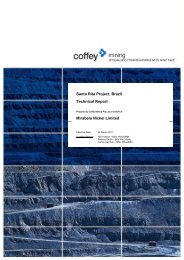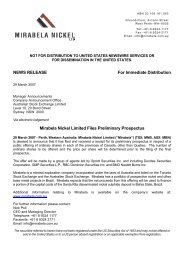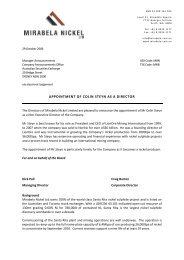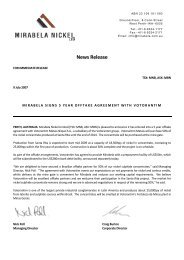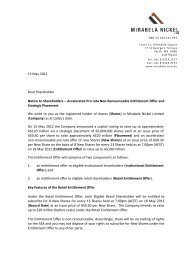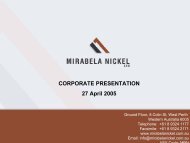COPY OF FINAL PROSPECTUS - Mirabela Nickel
COPY OF FINAL PROSPECTUS - Mirabela Nickel
COPY OF FINAL PROSPECTUS - Mirabela Nickel
You also want an ePaper? Increase the reach of your titles
YUMPU automatically turns print PDFs into web optimized ePapers that Google loves.
Metallurgy<br />
The Santa Rita deposit contains nickel sulphide as well as lesser amounts of nickel oxides. A comprehensive<br />
testwork program has been undertaken on the nickel sulphides to determine the mineralogical, comminution<br />
and metallurgical properties of the various mineralised zones within the deposit.<br />
The key results of the metallurgical testwork program are as follows:<br />
• the Santa Rita deposit can be categorized into two major mineralogical types; peridotite, which<br />
represents approximately 65% of the deposit and has approximately 20% of the nickel associated with<br />
silicates and hence has a maximum recovery of approximately 70%; and pyroxenite, which represents the<br />
remainder of the deposit and has an increased component of nickel sulphide and as a consequence, an<br />
improved nickel recovery of between 75% and 80%;<br />
• the samples are in the medium range in terms of competency for crushing and grinding. The<br />
comminution results also indicated that SAG milling would be appropriate for these samples;<br />
• a nickel concentrate grade of 13% to 14% can be achieved via conventional flotation at a recovery of<br />
between 66% and 68%;<br />
• there is potential for improvements in both nickel grade and nickel recovery. This would most likely be<br />
achieved through further optimisation of the flotation parameters and concentrate regrind options. It<br />
should be noted that the overall nickel recovery will remain limited to a large extent by the percentage of<br />
nickel associated with sulphides in the deposit;<br />
• the settling properties of the flotation tail are acceptable in terms of flocculent consumption, thickener<br />
capacity, underflow density and overflow liquor clarity; and<br />
• additional testwork is to be completed on samples of the flotation concentrate. The lack of completed<br />
testwork in this area would be considered to be a low risk.<br />
Mining Operations<br />
Mining Methods<br />
The current mining plan is based on exploiting the Santa Rita disseminated nickel sulphide deposit by<br />
conventional open pit mining techniques using backhoe excavators and off-road dump truck equipment. These<br />
mining methods are common in Brazil. Included in these operations will be normal drilling, blasting, loading,<br />
hauling activities, as well as the supporting functions of dewatering, grade control and equipment maintenance.<br />
Appropriate personnel training and development of the workforce will be undertaken to ensure that all<br />
operators and supervisors have the necessary skills base and experience to carry out the various mining activities<br />
in a safe, efficient and effective manner.<br />
Process Plant Design<br />
The proposed process plant to treat the Santa Rita deposit consists of primary crushing, conventional SAG<br />
and ball milling, followed by a flotation circuit. It is proposed that material be delivered to a primary crusher by<br />
a front end loader and/or 100 tonne dump trucks. The primary crusher would reduce the ROM feed to P 80 size<br />
of 120mm. This material will then be conveyed to a coarse ‘ore’ stockpile where it could be fed at a steady rate to<br />
the milling circuit.<br />
A comprehensive study has been undertaken in respect of the milling circuit, which would have a 8 MW<br />
SAG mill in open circuit with a 5.8 MW ball mill to produce a rougher feed at a P 80 grind size of 125m. The<br />
capacity and configuration of the comminution circuit is considered acceptable by RSG Global, particularly with<br />
the provision to include a pebble crusher and a regrind mill if necessary later in the project.<br />
The comminution properties of potential mining dilution was not tested, however the geological assessment<br />
indicated that there is unlikely to be any material difference in the competency of the mineralised zones as<br />
opposed to the waste zones.<br />
35




